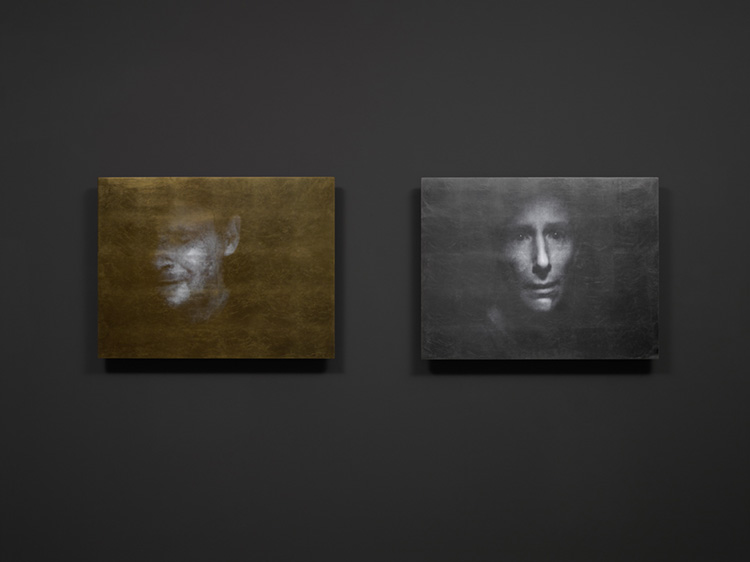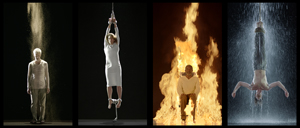



For more information
please contact:
James
Cohan
New York
Kukje Gallery
Seoul
Southern & Partners
London
Or, contact us.
|
|
BILL VIOLA
1951–2024
The unfolding of consciousness,
the revelation of beauty, present even after death,
the moment of awe, the space without words,
the emptiness that builds mountains,
the joy of loving, the sorrow of loss,
the gift of leaving something behind for the next traveler.
—BV

Viola on location for Room for St. John of the Cross, recording Sierra Nevada mountains near Lone Pine, Owens Valley, CA, April 1983
Photo by Kira Perov © Bill Viola Studio
JULY 13, 2024 — It is with great sadness that we share the news of the death of Bill Viola, one of the world’s leading contemporary artists.
He passed away peacefully at home on July 12th, at the age of 73. The cause was Alzheimer’s Disease. Viola is survived by his wife and longtime creative collaborator, Kira Perov, executive director of Bill Viola Studio, sons Blake and Andrei Viola and daughter-in-law Aileen Milliman.
Viola was a pioneer in the fields of new media, video, and installation art. For over 50 years his visionary environments, defined by immersive video and soundscapes, focused on the fundamental human experiences of birth, death, and the unfolding of consciousness. By slowing down the images, Viola shifted viewers’ sense of perception and awareness to reveal the inner world.
Read more ...
SOLO EXHIBITIONS

March 29–August 24, 2025
BILL VIOLA: THE RAFT
Joslyn Art Museum, Omaha, Nebraska
GROUP EXHIBITIONS
NORTH AMERICA

May 16-July 25, 2025
Four Hands (2001), All About 25
James Cohan, 52 Walker, New York, USA

June 2024–late 2025
The Sleepers (1992), and Witness (2001), Fondation Giverny
Installed at Fondation Giverny, 3333 Boul Crémazie E, Montréal, QC, Canada
Also on view, at the Observatoire à Shefford, QC location:
The Return (2007), The Fall into Paradise (2005) and Observance (2002)
photo: document original

March 25, 2022–July 26, 2026
The Quintet of the Silent (2000), The Clowes Pavilion Reimagined
Indianapolis Museum of Art at Newfields, Indiana, USA
EUROPE

June 27–November 16, 2025
Unspoken (Silver & Gold), 2001, A conversation without words
Musée Jenisch Vevey, Switzerland

May 16, 2025–TBD
Ancestors (2012), All Directions: Art That Moves You
FENIX, Rotterdam, The Netherlands

April 30, 2025–August 18, 2025
Chott el-Djerid (A Portrait in Light and Heat), 1979,
Out of focus. Another vision of art, from 1945 to the present day
Musée de l'Orangerie, Paris, France

April 19, 2025–January 4, 2026
Isolde's Ascension (The Shape of Light in the Space After Death), 2005,
Erotica - Beyond Beauty and Shame
Limburgs Museum, Venlo, The Netherlands

April 17–November 16, 2025
The Night Journey (2007-2018), GamePlay. Playing For Impact
MO Museum, Vilnius, Lithuania

April 11-–October 12, 2025
Surrender (2001), Another Gaze. Works from the collection of Gemma De Angelis Testa (in Italian)
Villa Panza, Varese, Italy

April 4, 2025–September 20, 2026
Stations (1994), The Story That Never Ends. The ZKM Collection
ZKM Center for Art and Media Karlsruhe, Germany

February 23–June 29, 2025
Self Portrait, Submerged (2013), Il Ritratto dell’Artista (in Italian)
Museo Civico San Domenico Forlì, Italy
ONGOING
Self Portrait, Submerged (2013), Collezione degli autoritratti, Gallerie degli Uffizi, Florence, Italy
The Night Journey (2007–2018), zkm_gameplay. the next level, ZKM | Center for Art and Media, Karlsruhe, Germany
Ocean Without a Shore (2007), Pennsylvania Academy of the Fine Arts (PAFA), Philadelphia, Pennsylvania [CLOSED until 2026 for renovations]
Ocean Without a Shore (2007), PLANTA - Sorigué, Balaguer (Lleida), Spain
Martyrs (Earth, Air, Fire, Water) (2014), and Mary (2016), Commissions for St Paul's Cathedral, London, UK
PAST EXHIBITIONS
|
NOW AVAILABLE

In 2004, the opera scene was taken by storm by the
ground-breaking production of Richard Wagner's opera
Tristan und Isolde in Los Angeles. This book offers a
behind-the-scenes look at how the visionary American
artist Bill Viola created four hours of video as a visual
complement to this profound psychological drama.
It also tells the story of its commissioning by the then
Paris Opera director Gerard Mortier, who pushed the
boundaries of what opera could be by inviting a trinity
of California-based creatives to re-imagine a
Tristan und Isolde for our times.
For more detailed information, view the book sheet.
Distributed for Mercatorfonds, available through Amazon,
Yale University Press, Barnes & Noble and other booksellers.

The Night Journey (2007–2018), is a collaboration
between Bill Viola and USC Game Innovation Lab,
including award winning game designers Tracy
Fullerton,Todd Furmanski and Kurosh ValaNejad
The Night Journey is one of the first experimental art
games ever made. It uses both game and video
techniques to tell the universal story of an individual’s
journey toward enlightenment.

2014 monograph by John G. Hanhardt, ed. Kira Perov

The Gerald Fox film, "Bill Viola: The Road to St Paul's"
Available on DVD through Arthaus Musik GmbH
|
![]()